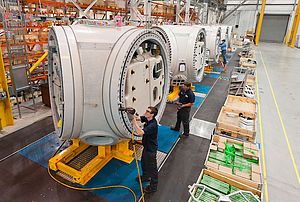One of the biggest challenges for food manufacturers is keeping up with new trends. While edible algae is unlikely to catch on, despite the efforts of some health bloggers, the demand for plant-based, high-protein foods is one example of how consumer trends affect food production. Here, Jasper Boudewijns, account manager and industrial automation specialist at Novotek, looks at the value of digital scheduling in meeting increased demand. Whenever a new trend comes along in the food industry, customer demand peaks quickly and manufacturers must adapt rapidly. This often means modifying recipes, recalibrating system settings and adjusting the production schedule. However, the plant manager still has the same facilities and manpower. This makes adapting to demand a challenge and often creates problems.
Plants must operate at optimum efficiency, with minimal downtime to ensure that the production can meet the output required by the customer. Production needs to be closely monitored and scheduled, otherwise the required amount of product will simply not be produced. Currently, many plant managers use Excel spreadsheets to schedule production. However, with increased digitalisation across the whole plant, it seems illogical to base the production schedules on a manually created process that is open to human error and takes up valuable time. Managing production schedules is almost like a puzzle. The plant manager must decide which product should be produced first and how much of each product to manufacture to meet the customer’s needs. While it could take the operator an hour to go through the different possibilities for production scheduling to find the optimum output, some production scheduling tools can work through the different options within a minute. By using a digital scheduling tool, not only will the plant manager reduce the time taken to work out a schedule for the plant’s production, they will have a better overview of the plant.
Visualisation
GE’s ROB-EX production scheduling tool has a visually simple dashboard that allows the involved managers to visualise the different production routes, stages in production, the workload and material consumption. Visual aids, such as different colours for different statuses, helps management to have a better understanding at a glance of how they are producing, which choices they should make and what is going on in the plant. A scheduling tool like this should be connected with the enterprise resource planning (ERP) or supply chain management (SCM) system. ROB-EX has standard connectors for major ERP and SCM suppliers such as VISMA and SAP, so it can be easily integrated into an existing system, rather than creating additional workload for management. The scheduling tool allows plant managers to generate possibilities about what production needs to be take place and what materials are needed for the processes. This allows production to be managed in the most resource and time efficient manner.
Downtime
Downtime is a big problem in the food industry and even more so for manufacturers that are under increased pressure to produce products to tight deadlines. Any bottlenecks in production due to missing materials or poorly planned schedules can lead to the food manufacturer failing to meet the customer’s deadline. An effective scheduling tool will immediately show any bottlenecks in resources, capacity or raw material. This should then be actionable data for the plant manager, who is able to optimize their production plan continuously, rather than acting reactively after the production has stopped.
Contamination
As anyone involved in the food production industry will know, contamination is a serious concern. Nuts, for example, have been identified by the EU as one of the most common ingredients causing food allergies and intolerances. Production therefore needs to be planned carefully to allow for the deep cleaning procedures to take place between the production of nut based products and nut free products. While it can be difficult for the operator to balance the production schedule with concerns about contamination, a scheduling tool can take heed of the allergens contained within different products. It will then schedule production with this in mind. For example, products containing peanuts would be produced at the end of a shift pattern, allowing production to stop as scheduled for the cleaning to take place, rather than having to stop production to clean in the middle of a shift. Production schedules are quite difficult to manage because of the huge amounts of products that often need to be produced, combined with the fluctuating demand and short lead times.
Vegetarian demand
Novotek has recently worked with one of the Netherland’s largest producers of vegetarian meat. The meat substitutes market is projected to grow at 6.8 per cent annually and reach $6.3 billion in 2023, so demand is high in this industry. Interest was also sparked recently when the French Government banned the use of phrases such as vegetarian sausages or vegetarian burgers to describe meat substitute products. This also increased production for Novotek’s customer by 25 per cent. The company recently invested in the ROB-EX scheduling tool to help their growth of up to 10 to 20 per cent every year. The company is having to produce a greater variety and volume of products with the same amount of people and equipment as before. The manufacturer therefore approached Novotek with the need to streamline its processes. While they were unsure as to what tool would help them do this, Novotek consulted with senior leaders from the plant to identify that a planning and scheduling tool would help them to achieve their goals. For this company, investing in a scheduling tool was relatively inexpensive and could be easily integrated with their existing IT- and forecasting systems. However, it allowed them to move away from manually planning production on a spreadsheet, to a better managed automated system. The system proposes the ideal production schedule from which the planner easily can choose. This removed the need to manually decide what to produce at what time. This increased efficiency and reduced downtime will allow the company to meet the needs of its customers in line with the growth of the vegetarian food market. This is just one example of a customer in a growing sector of the food industry where a scheduling tool allows them to better manage production to meet their customer’s targets. While growth in a market can be an opportunity for food manufacturers, if they are using old, manual systems, it can put too much pressure on planners and operators and lead to mistakes in planning production. By automating scheduling, plant managers can ensure that their production is planned correctly, and any potential issues are resolved before they arise. Edible algae is one trend that we wouldn’t have predicted several years ago, so we can only predict what the new food trends will be in years to come. With this in mind, plant managers should consider whether their current production scheduling system is up to task, and if an automated system would allow them to cope with a sudden increase in demand.























